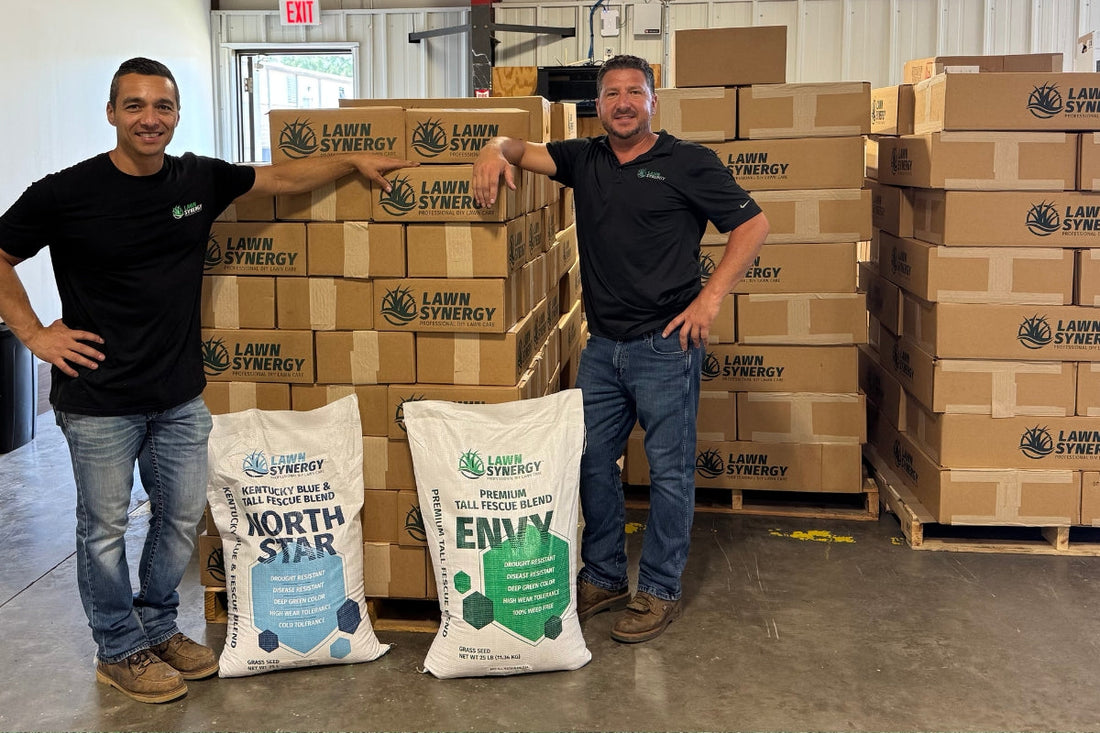Every homeowner wants a lawn that is green, dense, and durable, but the results start with the seed.
If you've ever asked yourself, 'What grass seed should I use?' you already know how overwhelming the options can be. With dozens of varieties and endless blends on the shelves, it's easy to pick the wrong type and end up with patchy, underperforming turf.
The good news is that selecting the right seed doesn't require guesswork.
By matching your grass type to your climate, soil, and goals, you can build a lawn that looks and performs like a professionally managed estate.
At Lawn Synergy, we've spent more than 30 years caring for elite properties. Today, we bring that same expertise to DIY homeowners, offering professional-grade seed, fertilizer, and step-by-step support that eliminates trial and error.
What this article covers:
- Why Choosing the Right Grass Seed Matters
- How To Choose The Right Grass Seed
- How to Prepare Your Lawn for Seeding
- Frequently Asked Questions About Choosing Grass Seed
Why Choosing the Right Grass Seed Matters
Grass type determines how your lawn looks, how much work it requires, and how well it handles stress.
Too often, homeowners choose seed based on color pictures on the bag or the cheapest price, only to find that the grass struggles in their soil or dies off in extreme weather.
A poor seed choice can lead to:
- Thin patches that never fill in
- Turf that burns out in summer or winter extremes
- Lawns overrun with weeds due to weak competition
- Higher water and fertilizer needs just to keep the grass alive
From experience, seed failures usually come from mismatches with soil and climate.
Taking the time to align your choice with local conditions avoids 90 percent of the problems we get called in to fix later. That's why we always recommend investing in high-quality grass seed.
Grass seed blends, such as North Star Blend and Envy Premium Tall Fescue, are tested, verified, and enhanced with nutrients for stronger establishment. This ensures that your investment turns into visible results.

How To Choose The Right Grass Seed
Not all lawns are alike, and the best seed for one homeowner might fail in another yard. Use this three-step framework to select a seed with confidence.
Step 1: Consider Your Climate Zone
Climate is the single biggest factor in determining success. Grass species are divided into cool-season and warm-season types.
- Cool-season grasses (Northern and Transition Zones): Thrive in soil temperatures between 50–70°F. They stay green in spring and fall, slow in summer heat, and survive winter. Examples include Kentucky bluegrass, perennial ryegrass, and multiple types of fescue grass.
- Warm-season grasses (Southern and Coastal Regions): Thrive in soil temperatures between 70–90°F. They peak in summer and go dormant in winter. Examples include Bermuda, zoysia, centipede, and the different types of St. Augustine grass (usually established by sod).
- Transition zones: Homeowners in areas that see both hot summers and cold winters often use blends or overseeding strategies to balance seasonal coverage.
In our experience, soil temperature (not calendar date) should guide planting. Many homeowners fail because they sow too early or too late.
Knowing what temperature kills grass seed helps you avoid wasted effort: below 40°F or above 95°F, germination rates plummet.
Step 2: Match Seed to Your Lawn's Conditions
Even within the right climate, your property has unique challenges. The seed you choose should match your lawn's daily environment.
- Sun vs shade: Full-sun lawns thrive with Bermuda or Kentucky bluegrass, while shaded areas demand fine fescues or shade-tolerant St. Augustine cultivars.
- Foot traffic: Families with kids and pets benefit from tall fescue or perennial ryegrass, which bounce back quickly.
- Soil type: Sandy soils dry fast, so drought-tolerant species like tall fescue or Bahia are ideal. Heavy clay soils need deep-rooting grasses to resist compaction.
- Moisture levels: If you live in a dry climate, drought-tolerant fescues or types of Bahia grass will stay green longer with less watering.
We've seen many homeowners overestimate their lawn's sunlight. Count actual hours of direct sun before choosing a seed. Grass adapted to shade can tolerate partial light, but sun-loving species planted in shade will always thin out.

Step 3: Choose the Right Grass for Your Goals
Your lifestyle and preferences also matter. Think about how you use your lawn and how much maintenance you're willing to provide.
- Low maintenance: Hard fescue or zoysia are slow-growing, needing less mowing and fertilizer.
- Fast germination: Ryegrass can sprout in under a week, making it excellent for overseeding or quick fixes.
- Lush, high-end look: Kentucky bluegrass or turf-type tall fescues create fine, dark-green blades for a premium appearance.
- All-season color: Overseeding warm-season lawns with ryegrass keeps them green in winter, while blends of cool-season grasses extend coverage in transition zones.
How to Prepare Your Lawn for Seeding
Choosing the right seed is only half the job. Proper preparation ensures that your seed establishes quickly and fully.
- Test your soil: Soil pH and nutrients determine whether the seed can thrive. Use a soil test kit before seeding to correct imbalances. Fescues, for example, prefer a pH between 5.5 and 7.5, while Bermuda prefers closer to neutral.
- Aerate and dethatch: Break up compacted soil and remove thatch to improve seed-to-soil contact. In clay-heavy yards, apply Gypsum Soil Conditioner to loosen the structure.
- Fertilize at planting: A balanced starter fertilizer such as Starter Fertilizer 15-20-10 encourages strong early root development.
- Seed correctly: Spread evenly with a broadcast spreader and lightly rake for soil contact. Avoid burying too deeply – most seeds should sit at 1/4 inch or less.
- Protect your seed: Cover with Seed Aide Cover Grow to lock in moisture, prevent erosion, and buffer against temperature swings.
Homeowners often overlook mowing height after germination. Keep new grass at 3–4 inches to shade the soil and protect fragile roots. Cutting too short is one of the fastest ways to kill young lawns.

Frequently Asked Questions About Choosing Grass Seed
What's The Easiest Grass Seed For Beginners?
Tall fescue is one of the easiest grass seeds for beginners because it germinates quickly and adapts to a wide range of soils. It also tolerates drought better than many cool-season grasses, making it more forgiving if watering or mowing isn't perfect.
Can I Mix Different Types Of Seed Together?
Yes, mixing seed types is common and often beneficial. Blends provide better disease resistance, balance sun and shade tolerance, and adapt more easily to changing weather. For example, combining ryegrass with tall fescue adds both fast germination and long-term durability.
What's The Fastest-Growing Grass Seed?
Perennial ryegrass is one of the fastest, often sprouting within five to seven days when soil temperatures are right. Because it establishes quickly, it is frequently used for overseeding or patch repairs where fast coverage is needed.
Which Seed Is Best For Shade?
Fine fescues such as creeping red or chewings fescue grow well in shaded northern lawns and require less maintenance than bluegrass. In southern regions, shade-tolerant St. Augustine varieties are better suited than Bermuda or zoysia for areas with partial light.
How Do I Know If My Soil Is Ready For Seed?
Soil is ready for seeding when it is within the correct germination temperature range for the grass type and has balanced nutrients. A soil test can confirm pH and fertility, helping you avoid poor establishment caused by nutrient deficiencies or improper soil conditions.
Conclusion
Cool-season grasses such as fescues and ryegrass excel in northern regions, while Bermuda, zoysia, and St. Augustine thrive across the South.
For shaded lawns, fine fescues or select warm-season cultivars are dependable choices. For high-traffic yards, tall fescue or ryegrass delivers lasting resilience.
At Lawn Synergy, we've taken more than 30 years of estate-care experience and applied it to products built for DIY success.
From certified seed blends to nutrient-rich fertilizers and soil conditioners, everything we offer is designed to give homeowners professional-level results without filler or guesswork.
Along with pro-grade products, we provide timing advice and support so you know exactly when and how to seed for the strongest results.
A lawn built on the right seed isn't just green – it's resilient, low-stress, and something you can be proud of season after season. Choosing the right grass seed is the first step.
Ready to learn more about lawn care? Check out these articles:

